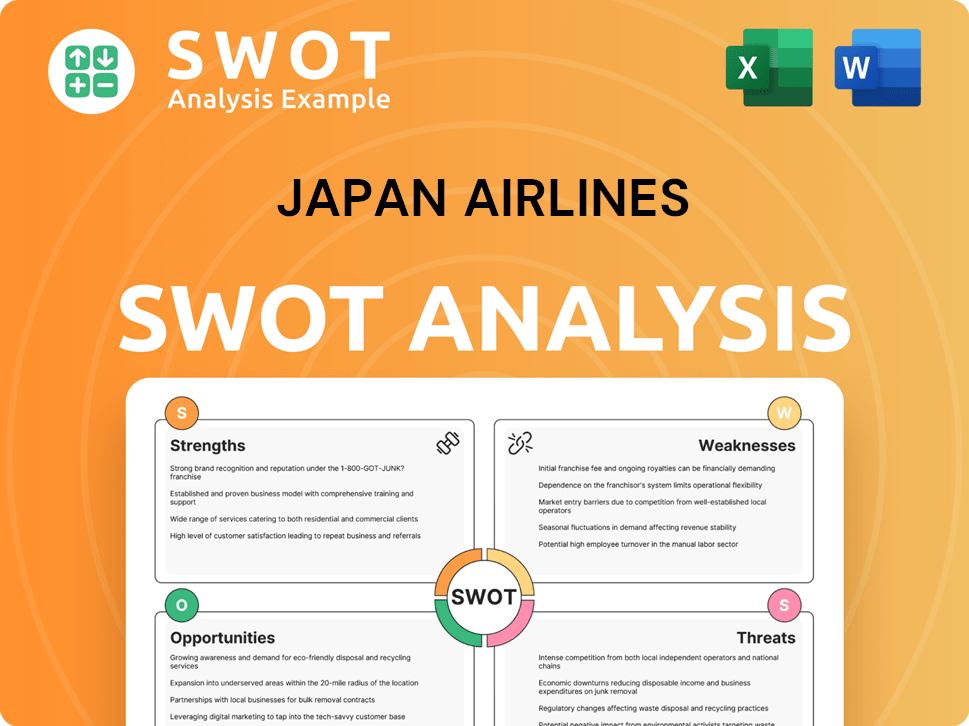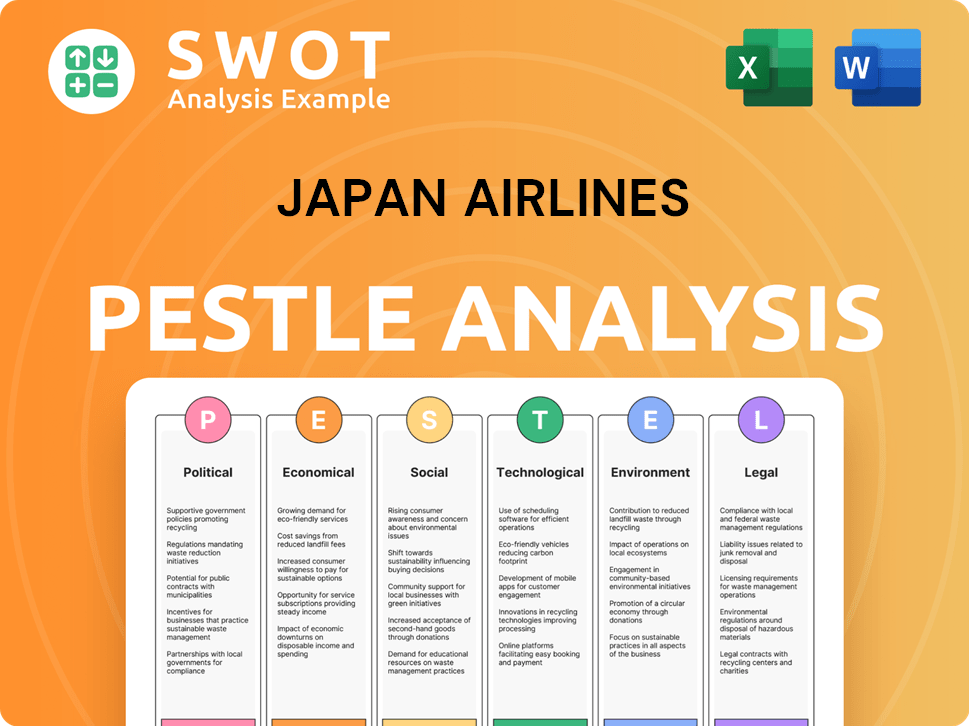Japan Airlines Bundle
Can Japan Airlines Maintain Its Ascent in the Dynamic Aviation Market?
Japan Airlines (JAL) has soared to new heights, achieving record-breaking revenue and demonstrating remarkable resilience in the face of global challenges. Its impressive financial performance, including a substantial increase in passenger numbers, underscores its ability to adapt and thrive. This success story, however, prompts a deeper dive into its strategic roadmap for continued growth.

To understand JAL's trajectory, we must examine its Japan Airlines SWOT Analysis, which reveals key strengths, weaknesses, opportunities, and threats. The airline's expansion plans, particularly in international markets, are crucial for sustained growth. Analyzing JAL's growth strategy provides valuable insights into the future of the airline industry and its impact on the Japanese economy.
How Is Japan Airlines Expanding Its Reach?
Japan Airlines (JAL) is actively pursuing a multi-faceted growth strategy to strengthen its position in the airline industry and increase revenue. This strategy includes significant expansion initiatives focused on international routes, fleet modernization, and the development of new business models. These efforts are designed to capitalize on evolving market demands and enhance the overall customer experience.
The airline's expansion plans are strategically aligned with the recovery of the aviation market and the anticipated growth in travel demand. By introducing new destinations and increasing flight frequencies, JAL aims to capture a larger share of the market and improve its financial performance. The strategic focus on both geographical expansion and fleet upgrades reflects a commitment to long-term growth and sustainability within the Japanese economy.
JAL's expansion strategy is multifaceted, encompassing route network growth, fleet modernization, and strategic partnerships. The airline is making significant investments to enhance its operational capabilities and improve its competitive position in the aviation market. These initiatives are designed to support JAL's long-term growth objectives and adapt to the changing dynamics of the airline industry.
JAL is actively expanding its international route network to capitalize on increased travel demand. New routes to destinations like San Francisco and Bangalore were introduced in 2024. For the fiscal year 2025, JAL is launching a new service from Tokyo Narita (NRT) to Chicago (ORD) on May 31, 2025.
The airline is increasing flight frequencies on existing routes to meet growing demand. Flights from Osaka (KIX) and Nagoya (NGO) to Honolulu will increase. The Narita-San Diego and Narita-Bengaluru routes will operate daily from March 30 to October 25, 2025. The Narita-Honolulu service will double to twice-daily throughout July 2025.
JAL is modernizing its fleet to enhance service and increase capacity. The airline plans to add ten Boeing 787-9s and twenty Airbus A350-900s from FY2027. The Airbus A350-1000, featuring improvements in Premium Economy, was introduced on international routes in January 2024 and will be deployed on the Haneda-Paris route starting May 1, 2025.
JAL is expanding its low-cost carrier (LCC) segment, including ZIPAIR and SPRING JAPAN. ZIPAIR saw a 39.1% revenue increase in FY2024-25. ZIPAIR aims to increase its fleet from eight to ten aircraft by FY2025 and expand routes to the North American West Coast and Asia.
JAL is forming strategic partnerships to strengthen its market presence and boost transpacific travel demand. A partnership with Major League Baseball was established in December 2024 to develop sports tourism initiatives. These partnerships are designed to enhance the customer experience and drive revenue growth.
- The expansion into Southeast Asia and India aims to connect these regions with North America.
- Fleet modernization includes the introduction of the Airbus A350-1000, enhancing the Premium Economy class.
- ZIPAIR's expansion focuses on fleet growth and route diversification, including the North American West Coast.
- Partnerships, like the one with Major League Baseball, support sports tourism and boost transpacific travel.
Japan Airlines SWOT Analysis
- Complete SWOT Breakdown
- Fully Customizable
- Editable in Excel & Word
- Professional Formatting
- Investor-Ready Format

How Does Japan Airlines Invest in Innovation?
Japan Airlines (JAL) is heavily investing in innovation and technology to boost operational efficiency, improve customer experience, and ensure sustainable growth. This strategic focus is crucial in today's competitive aviation market, especially as the airline navigates the complexities of the Japanese economy and the global airline industry. A core element of this strategy involves digital transformation (DX), aimed at integrating technology across all facets of the business.
As of April 1, 2025, JAL's Digital Technology Division and JAL Information Technology Co., Ltd. (JIT) are merging their organizational structures. JIT will be renamed JAL Digital Co., Ltd. (tentative name). This integration, which started in April 2024 with the centralization of JAL's DX strategy, is designed to accelerate company-wide DX initiatives and create value through enhanced digital promotion. This move underscores JAL's commitment to leveraging technology to maintain and expand its market share.
JAL is actively utilizing cutting-edge technologies like AI, IoT, and quantum computing. The airline is developing an AI-powered app, JAL-AI, to streamline how cabin attendants document in-flight events, potentially reducing reporting time by up to two-thirds. This app uses Microsoft's Phi-4 small language model and is part of a broader generative AI rollout, giving all 36,500 JAL Group employees access to AI tools for various tasks. The application of AI extends to aircraft maintenance, where JAL and JAL Engineering have received the 'IT Award (Open Innovation Area)' for the third consecutive year in December 2024, acknowledging their 'Zero Zero 100' initiative. This initiative focuses on predictive maintenance through AI-driven failure prediction algorithms and improved engine diagnostics using medical image recognition AI. JAL is also exploring quantum computing to optimize aircraft maintenance planning, which is essential for efficiency.
JAL is centralizing its digital transformation strategy to accelerate company-wide DX initiatives.
This includes integrating the Digital Technology Division and JIT into JAL Digital Co., Ltd.
JAL is developing the JAL-AI app to improve in-flight event documentation.
AI is also used in aircraft maintenance for predictive maintenance and improved diagnostics.
JAL is exploring quantum computing to optimize aircraft maintenance planning.
This technology aims to streamline complex scheduling constraints.
JAL is incorporating drone technology into its logistics and healthcare sectors.
This includes developing an Air Mobility Operation Platform (AMOP) for managing air mobility services.
JAL is developing a flight management system to control multiple drones with a single operator.
This aims to reduce operational costs and improve efficiency.
JAL's technological advancements support its sustainability initiatives.
These include reducing fuel consumption and optimizing flight paths.
Beyond traditional aviation, JAL is exploring new domains through technology. The airline is incorporating drone technology into its logistics and healthcare sectors. This initiative includes the development of an Air Mobility Operation Platform (AMOP) for managing next-generation air mobility services, with particular potential in delivering lightweight, high-value, and time-sensitive medical supplies. JAL is also developing a flight management system that allows a single operator to control multiple drones, significantly reducing operational costs and improving efficiency. These initiatives highlight JAL's commitment to exploring Japan Airlines' marketing strategy and future plans.
JAL's technology strategy focuses on digital transformation, AI, and quantum computing to enhance operations and customer experience. The airline is also exploring drone technology for logistics and healthcare applications.
- Digital Transformation: Centralizing DX strategy and integrating IT operations.
- AI Applications: Implementing AI-powered apps for cabin crew and predictive maintenance.
- Quantum Computing: Utilizing quantum computing for optimized aircraft maintenance planning.
- Drone Technology: Developing an AMOP and flight management systems for drone operations.
- Sustainability: Leveraging technology to reduce fuel consumption and optimize flight paths.
Japan Airlines PESTLE Analysis
- Covers All 6 PESTLE Categories
- No Research Needed – Save Hours of Work
- Built by Experts, Trusted by Consultants
- Instant Download, Ready to Use
- 100% Editable, Fully Customizable

What Is Japan Airlines’s Growth Forecast?
The financial outlook for Japan Airlines (JAL) is positive, reflecting a strong recovery and ambitious growth plans. JAL's strategic initiatives and the resurgence of air travel have fueled impressive financial results. The company's focus on operational efficiency and customer satisfaction is expected to drive further growth in the coming years, positioning it favorably within the aviation market.
For the fiscal year ending March 2024, JAL reported record revenue of ¥1.52 trillion, marking a significant year-on-year increase. This strong performance underscores the effectiveness of its growth strategy and its ability to capitalize on the recovery in the airline industry. The company's financial health is further supported by its strategic investments and focus on sustainable practices.
JAL's financial performance demonstrates its resilience and strategic foresight, positioning it for sustained success in the competitive aviation market. As highlighted in Revenue Streams & Business Model of Japan Airlines, JAL's diversified revenue streams and efficient business model contribute to its financial stability and growth potential.
JAL achieved a record revenue of ¥1.52 trillion. Operating profit was ¥200 billion, and net income reached ¥140 billion. These figures reflect a robust recovery and effective cost management.
Consolidated revenue reached JPY 1,844 billion, an 11.6% increase year-on-year. EBIT grew by 19% to JPY 172.4 billion, and net profit was JPY 107.0 billion, up 12% year-on-year. This performance highlights the company's growth strategy.
JAL projects consolidated revenue of JPY 1,977.0 billion. The company anticipates an EBIT of JPY 200.0 billion and a net profit of JPY 115.0 billion. These forecasts are driven by sustained passenger demand and strategic expansions.
The annual dividend for FY2024-25 increased from JPY 80 to JPY 86 per share. The forecast for FY2025-26 is JPY 92 per share, maintaining a 35% payout ratio. Investments include 310 billion yen for FY2024 and 240 billion yen for FY2025.
JAL aims to achieve an EBIT of JPY 230 billion by FY2028, further enhancing corporate value. The LCC segment is projected to see significant EBIT growth, aiming for 30 billion yen by FY2028, a 58% increase over FY2025.
- Focus on route expansion and international flights.
- Investments in fuel-efficient aircraft.
- Strategic partnerships to enhance market presence.
- Emphasis on customer service and technological advancements.
Japan Airlines Business Model Canvas
- Complete 9-Block Business Model Canvas
- Effortlessly Communicate Your Business Strategy
- Investor-Ready BMC Format
- 100% Editable and Customizable
- Clear and Structured Layout

What Risks Could Slow Japan Airlines’s Growth?
Several risks and obstacles could hinder the growth strategy of Japan Airlines (JAL). These challenges include market volatility, geopolitical issues, demographic shifts, labor shortages, and regulatory changes. Addressing these issues is crucial for JAL to maintain its competitive position in the aviation market.
Market dynamics and external factors can significantly impact JAL's operations and financial results. Currency fluctuations, supply chain disruptions, and evolving environmental regulations present ongoing hurdles. JAL must proactively manage these risks to ensure sustainable growth and operational efficiency.
JAL's success also depends on adapting to changing market conditions and proactively mitigating potential threats. This involves strategic planning, operational adjustments, and a commitment to innovation. The company's ability to navigate these challenges will determine its future performance.
Exchange rate fluctuations, particularly between the U.S. dollar and the Japanese Yen, can significantly impact JAL's financial performance. As a global airline, JAL's revenues and costs are influenced by currency movements. Stronger U.S. dollar can increase operational costs, affecting profitability.
Geopolitical events, such as airspace closures, force flight rerouting, which increases fuel consumption and operational expenses. Supply chain disruptions make it difficult to source aircraft parts, leading to delays and higher costs. These factors affect JAL's operational efficiency and profitability.
Japan's aging and shrinking population reduces the domestic air travel market, particularly affecting regional routes. This demographic trend poses a long-term challenge to the sustainability of some routes. JAL must adapt its strategies to address declining passenger numbers.
Labor shortages across the aviation sector, including pilots, technicians, and ground staff, threaten JAL’s operations. These shortages can impact flight schedules and service quality. Addressing these shortages is crucial for maintaining operational efficiency and supporting growth.
Japan's commitment to net-zero carbon emissions by 2050 necessitates the adoption of sustainable aviation fuel (SAF) and other green initiatives. These initiatives introduce new financial burdens and compliance costs. JAL is working to achieve net-zero CO2 emissions by 2050.
JAL employs business model reforms, diversification, and strategic investments to mitigate risks. The company is restructuring its full-service carrier and cargo segments to generate profits. Additionally, JAL emphasizes safety and operational excellence. For more details on JAL's financial structure, see Owners & Shareholders of Japan Airlines.
Currency fluctuations can lead to increased operational costs. For example, a strengthening U.S. dollar can make fuel and maintenance expenses more expensive for JAL. This can directly affect the airline's profit margins. JAL's financial performance is closely tied to these external economic factors.
Rerouting flights due to airspace closures increases fuel consumption, adding to operational costs. Supply chain disruptions cause delays in obtaining aircraft parts and performing maintenance. These issues can disrupt flight schedules and impact customer satisfaction. Delays can also impact JAL's ability to expand its route network.
A shrinking population reduces demand for domestic air travel, especially on regional routes. Labor shortages across the aviation sector can lead to flight cancellations and reduced service quality. These combined factors could limit JAL’s growth potential. Addressing these issues is crucial for long-term sustainability.
The adoption of sustainable aviation fuel (SAF) and other green initiatives introduces new financial burdens. The Carbon Offsetting and Reduction Scheme for International Aviation (CORSIA) adds to operational costs. JAL must invest in sustainable practices to meet environmental goals. These investments may impact short-term profitability.
Japan Airlines Porter's Five Forces Analysis
- Covers All 5 Competitive Forces in Detail
- Structured for Consultants, Students, and Founders
- 100% Editable in Microsoft Word & Excel
- Instant Digital Download – Use Immediately
- Compatible with Mac & PC – Fully Unlocked

Related Blogs
- What are Mission Vision & Core Values of Japan Airlines Company?
- What is Competitive Landscape of Japan Airlines Company?
- How Does Japan Airlines Company Work?
- What is Sales and Marketing Strategy of Japan Airlines Company?
- What is Brief History of Japan Airlines Company?
- Who Owns Japan Airlines Company?
- What is Customer Demographics and Target Market of Japan Airlines Company?
Disclaimer
All information, articles, and product details provided on this website are for general informational and educational purposes only. We do not claim any ownership over, nor do we intend to infringe upon, any trademarks, copyrights, logos, brand names, or other intellectual property mentioned or depicted on this site. Such intellectual property remains the property of its respective owners, and any references here are made solely for identification or informational purposes, without implying any affiliation, endorsement, or partnership.
We make no representations or warranties, express or implied, regarding the accuracy, completeness, or suitability of any content or products presented. Nothing on this website should be construed as legal, tax, investment, financial, medical, or other professional advice. In addition, no part of this site—including articles or product references—constitutes a solicitation, recommendation, endorsement, advertisement, or offer to buy or sell any securities, franchises, or other financial instruments, particularly in jurisdictions where such activity would be unlawful.
All content is of a general nature and may not address the specific circumstances of any individual or entity. It is not a substitute for professional advice or services. Any actions you take based on the information provided here are strictly at your own risk. You accept full responsibility for any decisions or outcomes arising from your use of this website and agree to release us from any liability in connection with your use of, or reliance upon, the content or products found herein.